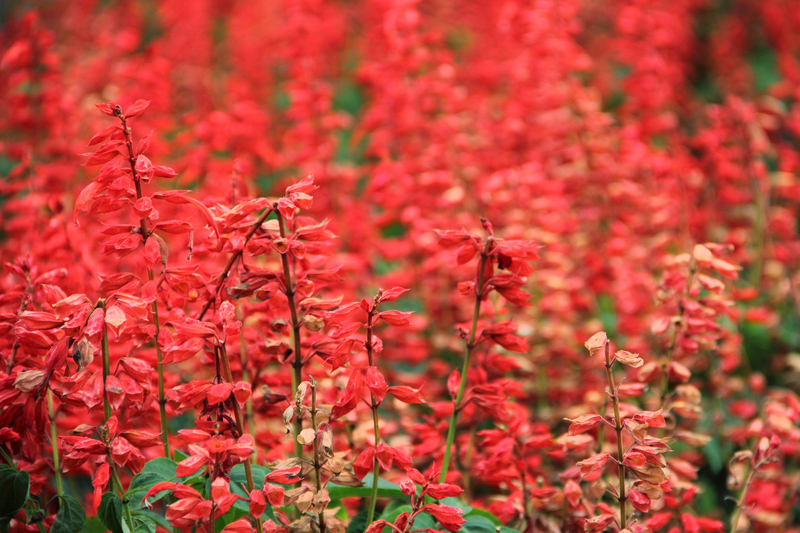Discover New Ways to Handle Stubborn Weeds
Posted on 23/09/2025
Discover New Ways to Handle Stubborn Weeds
Weeds are the relentless intruders of gardens and landscapes. No matter how meticulous your maintenance, these unwelcome plants find ways to pop up, often thriving despite your best efforts. If you're tired of constant pulling and chemical overload, read on to discover new ways to handle stubborn weeds that are both innovative and eco-conscious. This comprehensive guide will introduce a toolkit of modern weed control techniques perfect for anyone seeking an effective, sustainable, and manageable approach to weed management.
Understanding Why Weeds Are So Persistent
Stubborn weeds have adapted over generations to survive and outcompete cultivated plants. Their seeds are resilient, sometimes lying dormant for years before germinating. Knowing why weeds are so persistent can help you develop smarter strategies for effective weed control.
- Deep Root Systems: Many tough weed species have roots that reach deep into the soil, making them difficult to uproot completely.
- Rapid Growth Cycles: Some weeds can mature in only a few weeks, spreading seeds before you even notice them.
- Adaptability: Weeds can adapt to various soil and environmental conditions, giving them an added advantage.
Understanding these traits is the first step to tackling stubborn weeds more intelligently.

Eco-Friendly Alternatives to Chemical Herbicides
Why Avoid Chemical Solutions?
While chemical herbicides can offer fast results, they often come with environmental and health concerns. Their overuse can damage soil health, harm beneficial insects, and contaminate water sources. This is one of the main reasons more gardeners and landscapers are exploring new ways to get rid of stubborn weeds that are safe, non-toxic, and sustainable.
Mulching: Nature's Protective Blanket
Mulching is a classic, low-effort way to suffocate weeds and enrich your soil at the same time. By applying a thick layer of organic mulch--like straw, wood chips, grass clippings, or shredded leaves--you can prevent sunlight from reaching weed seeds and disrupt their growth cycle.
- Suppresses Emerging Weeds: A proper mulch layer blocks light, discouraging germination.
- Improves Soil: As mulch breaks down, it adds organic matter, boosting soil structure and fertility.
- Retains Moisture: Mulching also helps maintain consistent soil moisture, which benefits your desired plants.
Boiling Water: A Simple Home Solution
If you're searching for a straightforward, inexpensive method to eradicate tough weeds, try pouring boiling water directly onto them. This extreme heat destroys plant tissues quickly, especially in cracks along pathways and driveways.
Be careful to avoid desired plants, as boiling water is non-selective and will damage most vegetation it touches.
Vinegar and Salt: Old Remedies, New Results
Using kitchen staples like vinegar and salt can be an effective way to target unwanted plants. A solution of household vinegar (5% acetic acid) mixed with salt and a dash of dish soap creates a potent spray for spot-treating persistent weeds. The acetic acid dries out leaf tissues, while salt interferes with water uptake.
- Works best on sunny days for quick desiccation.
- For larger weeds or those with taproots, repeat applications may be necessary.
- Use with caution: Salt can build up in the soil and harm other plants, so apply only where needed.
Mechanical and Manual Techniques for Weed Management
Hand Pulling with Ergonomic Tools
While arguably the oldest method, hand pulling remains highly effective for dealing with persistent weeds--provided you use the right tools and technique.
- Weed during damp conditions for easier root removal.
- Use ergonomic weeders or trowels to minimize effort and maximize root extraction.
- Dispose of weeds before they set seed to prevent future outbreaks.
Hoeing and Cultivating
Regular hoeing can disrupt weed seedlings at the surface before they have a chance to become established. Use a sharp hoe in shallow strokes to disturb weed root systems without damaging your crop roots.
This method is especially effective for gardens and vegetable beds, providing both aeration and weed control benefits.
Solarization: Harnessing the Power of the Sun
Looking for a seasonal solution? Soil solarization utilizes the sun's rays to kill weed seeds and pathogens lurking just below the surface. Here's how:
- Water the affected area thoroughly.
- Cover with clear plastic sheeting, weighed down at the edges.
- Leave for 4-6 weeks during the peak of summer.
- The trapped heat will destroy stubborn weed seeds and invasive roots.
Flame Weeding: Controlled Heat for Instant Results
Flame weeding is gaining popularity as a non-chemical approach, especially among organic farmers and gardeners. Using a flame weeder (a propane torch device), you quickly pass the flame over weeds, causing their cells to burst and effectively killing the plants.
- Best for driveways, gravel paths, and areas clear of flammable mulch or dry materials.
- Ideal for annual weeds and young seedlings.
- Use with caution--safety is paramount!
Proactive Strategies to Prevent Weed Infestations
Dense Planting and Ground Covers
One of the most effective approaches to weed management is to make sure bare soil is never left exposed. Dense planting and the use of living ground covers deprive weeds of sunlight and space to grow.
- Plant cover crops, such as clover or vetch, in vegetable gardens during the off-season.
- In ornamental beds, choose low-growing perennials or sprawling ground covers for long-lasting weed suppression.
Landscape Fabric and Barrier Materials
Landscape fabric offers a physical barrier that prevents weeds from poking through while still allowing air and water to reach the soil. For lasting pathways or outdoor seating areas, combine fabric with a dense mulch or gravel layer on top.
- Choose top-quality, UV-resistant fabric for best results.
- Overlap edges and secure with landscape pins to prevent sneaky invaders.
- Monitor for weeds that may appear on top of the fabric and remove promptly.
Regular Maintenance and Quick Response
Even the best weed control methods will be less effective without consistent garden care. Building habits like weekly patrols, frequent mulching, and immediate removal of emerging weeds will stop infestations before they start.
Embracing Innovative and Organic Weed Control Products
Natural Pre-Emergent Herbicides
Several commercially available weed preventers use natural ingredients such as corn gluten meal. When applied at the correct time (usually early spring), these products prevent weed seeds from sprouting, giving your desired plants a stronger head start.
Biodegradable Weed Mats and Paper Mulch
If you want eco-friendly convenience, try biodegradable weed mats or paper mulch. These products break down over time, adding organic matter to your beds, and are especially useful for vegetable rows and flower beds.
- Easy to install and replace each season.
- Suppress weeds and conserve soil moisture effectively.
Organic Herbicidal Soaps and Oils
Herbicidal soaps and citrus-based oils kill weeds by breaking down their leaf cuticles. While they may require repeated applications for tough weeds, they offer a safer alternative to synthetic chemicals.
- Best for young or actively growing weeds.
- Check product labels to ensure safety around pets and beneficial insects.
Common Mistakes to Avoid When Dealing with Tough Weeds
- Ignoring Early Signs: Small weeds quickly become large problems. Address new growth immediately.
- Disturbing Soil Excessively: Tilling exposes dormant weed seeds. Minimize unnecessary soil disturbance.
- Compromising Mulch Quality: Thin or poorly-aged mulch may harbor weed seeds. Always source high-quality materials.
- Overwatering: Weeds will thrive with excess moisture. Use targeted watering methods to support desirable plants and deprive weeds.

Integrating Multiple Methods for Long-Term Success
No single technique will handle every situation. The key to keeping persistent weeds under control is integrating several methods in a holistic management plan. For instance:
- Apply mulch after hand-pulling to prevent regrowth.
- Use boiling water or vinegar solutions on weeds emerging through gravel or pavement.
- Combine dense planting with spot treatments for especially aggressive species.
By alternating approaches and staying vigilant, you'll reduce weed populations and minimize the need for heavy interventions over time.
Conclusion: Rethink How You Manage Stubborn Weeds
Weeds may be stubborn, but with knowledge, planning, and a willingness to try new techniques, you can outsmart even the toughest invaders. As you've learned in this guide, there are many modern and eco-friendly weed control methods available--ranging from mulching and hand removal to solarization, boiling water, and innovative organic products.
Adopt a proactive, varied strategy, and you'll soon see your garden or landscape flourish while keeping weeds at bay. By employing these alternative weed management solutions, you can cultivate a healthy, beautiful environment--naturally and sustainably.
Ready to Discover Even More?
If you're eager to continue your journey to a weed-free garden, keep exploring, testing, and combining methods until you find the approach that works best for your space. Your diligence and creativity are your greatest allies in the ongoing battle against stubborn weeds.

